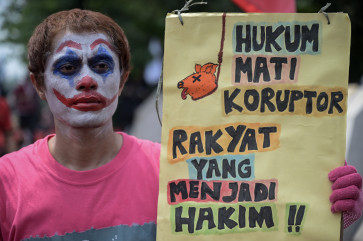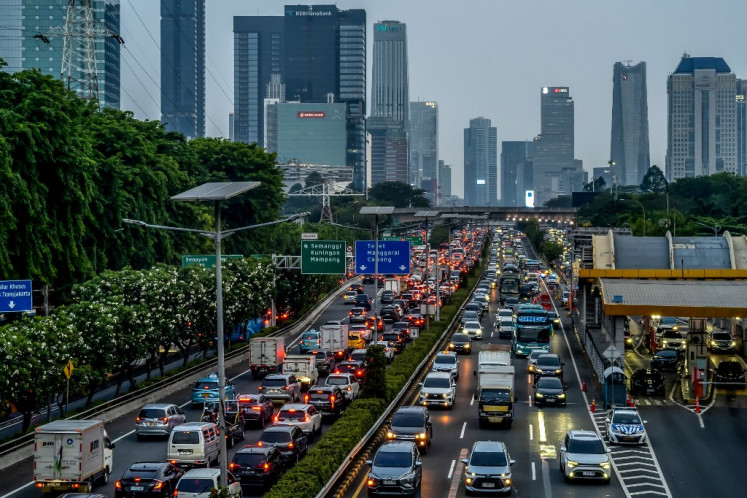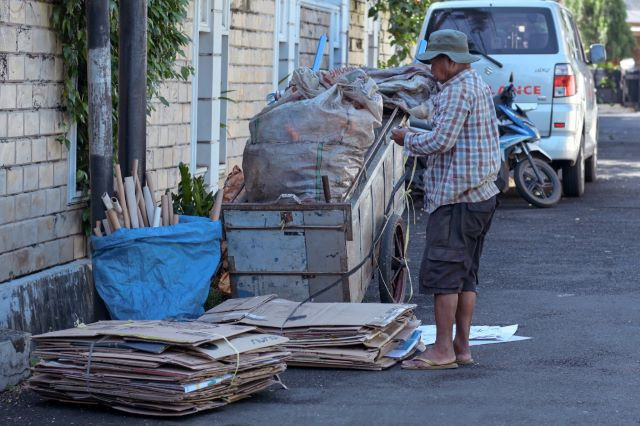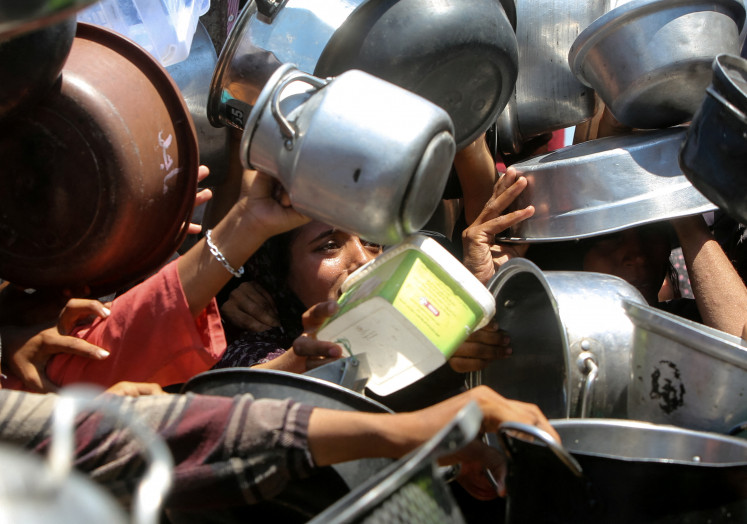Popular Reads
Top Results
Can't find what you're looking for?
View all search resultsPopular Reads
Top Results
Can't find what you're looking for?
View all search resultsMt. Lemongan: Locals bring nature back to life
Catastrophic oil spills that do not seem to end, reports of hectares of forests burning each minute despite the well-known dire consequences of deforestation, are a constant reminder of the ills humans impose each day on the Earth
Change text size
Gift Premium Articles
to Anyone
C
atastrophic oil spills that do not seem to end, reports of hectares of forests burning each minute despite the well-known dire consequences of deforestation, are a constant reminder of the ills humans impose each day on the Earth.
Green movement: Activists plant seeds of fruit trees in the cleared forest around the mountain. Although it will take years for the forest to return to its original state, local activists are intent on preserving the environment through various campaigns and conservation activities.
But it is not all doom and gloom in East Java. Efforts are underway to restore the lost springs around Mt. Lemongan and Lake Klakah (Ranu Klakah) near Tegalrandu village, Klakah district, Lumajang, East Java.
Local residents, environmentalists, artists and schoolchildren are all joining in to help, making
concerted efforts to preserve the environment.
Lake Klakah is one of three lakes around the volcanic slopes of Mt. Lemongan, the others being Lake Pakis and Lake Bedali, and lies about 190 kilometers from Surabaya, the capital of East Java.
The extraordinary landscape and breathtaking lake views mean tourists who want to take in the fresh air and refresh their senses regularly visit this spot.
Around sunrise and sunset sea birds can be seen gliding over the tranquil lake, fishermen dot its surface and in the distance Mt. Lemongan hovers proudly over all.
Many tourists, however, do not realize that Lake Klakah today is not as beautiful as it once was in the past. Nor do they know that the water level is dropping year by year. The maximum depth of Lake Klakah is now just 28 meters.
Local residents are witness to the gradually fading beauty of the lake. “In the past, the water was plentiful, especially in the rainy season,” said Irwan, a 40-year-old local shop worker who lives around Lake Klakah.
Irwan bemoaned the garbage around most of the shoreline of Lake Klakah, primarily caused by visitors discarding plastic garbage and algae growth.
He said the water began getting dirty in the late 1990s, when the residents created artificial ponds on the banks of lake.
“The ponds owners and fishermen brought special algae to grow here to feed the fish. And the algae do grow well here, but sometimes it makes the lake dirty. Garbage often seems to get caught in the algae,” Irwan said.
Widodo, a pond owner on Lake Klakah, did not agree that the ponds reduced the cleanliness of the lake. “Many people come to the lake and throw their garbage into the water,” he said. He would be happy when the areas surrounding the lake were cleaned up and hoped that Lake Klakah would be well promoted and developed seriously as a community-based tourism area.
“But this area suffers from a lack of water now, even in the rainy season at this time of year. I welcome the effort to restore the lost springs around Lake Klakah,” he said.
The once tree-covered slopes of Mt. Lemongan were the origin of the springs of Lake Klakah and its surrounding area.
Unfortunately, 6,000 hectares of forest in the Mt. Lemongan area were cleared, through vandalism and illegal logging, between 1998 and 2002.
At the end of 1990s, in the beginnings of the reform era, the political situation was still very unpredictable in the country.
People didn’t care much for forest areas, ignoring the fact it could take decades, even hundreds of years to restore a forest to its previous state after it has been logged.
The impact of deforestation has been felt everywhere, including on Mt. Lemongan. Previously, Mt. Lemongan was able to support 30 lakes.
Now, there are just nine. Before, local residents had at least 32 springs to choose from for their daily needs and rice fields. Now, only four remain.
Forty-seven percent of Lake Klakah residents — based on the 2000 census — work as farmers. Rice fields need a lot of water to flourish. So how many residents who live there now are still surviving as farmers?
Even I, who participated in the Green Camp multicultural event at Lake Klakah on March 20-21, 2010, felt how difficult it was to find clean water there, despite being the rainy season.
***
Man made: Fish farms located along the lake are finding it difficult to subsist, as a result of a decrease in the water supply, caused by deforestation in the forests around the mountain.
Laskar Hijau (Green Soldier), a voluntary organization for the conservation of Mt. Lemongan, was established at the end of 2008.
It now consists of various parties: local residents, environmental volunteers, arts workers, religious figures, etc. All members are aware of the latent dangers: drought and floods.
They came together for the purpose of regreening Mt. Lemongan, restoring the springs, preventing floods and landslides, and getting the rich natural biodiversity back. The group’s emphasis is on the awareness and participation of all parties that care about Mt. Lemongan and its surrounding area.
In 2009, local residents and Laskar Hijau working together regreened 300 hectares of Mt. Lemongan slopes.
“This means it will take 20 years to restore Mt. Lemongan’s 6,000-hectare ecosystem. We will continue to focus on regreening Mt. Lemongan for the next 20 years,” said A’ak Abdullah Al-Kudus, a Laskar Hijau volunteer.
Conservation methods have been being developed through the concept of hutan setaman (sustainable forest). The seeds planted and maintained are local fruits, conservation plants, rare plants and various kinds of bamboo, especially bamboo petung, jajang black, and the big bamboo andong.
Local elementary school students have been invited to work together to help with the seeds.
Hopefully, this will raise the students’ awareness about preserving Mt. Lemongan and its surrounding area.
Why choose fruit trees to be planted in the forests of Mt. Lemongan? “This is all for the community, so they will no longer cut wood to sell. As a livelihood, they can simply pick fruit in the forests of Mt. Lemongan,” said A’ak who lives around Mt. Lemongan.
Where do the fruit seeds come from? Initially, volunteers collected the seeds of fruit from garbage cans in the traditional market near Lake Klakah and then grew them. But now, residents collect seeds too.
Jackfruit and durian sellers in the traditional market also participate.
Although this plantation movement only started at the end of 2008, some plants are already bearing fruit. Various animals that had disappeared, especially birds, are slowly returning.
To remain sustainable, A’ak hopes that Mt. Lemongan will be reevaluated as protected forest land or national park, according to the laws and regulations.
***
No longer beautiful: A fisherman watches the sunrise from Klakah Lake, Lumajang, East Java, with Mt. Lemongan in the background. Forests around the lake were cleared during the early so-called reform era, reducing the lake’s water supply.
The community has been campaigning for the conservation of Mt. Lemongan in various ways, by for example organizing an annual event since 2006 called Maulid Hijau (Green Maulid).
Drawing inspiration from Maulid, a term used to refer to the birthday of the Prophet Muhammad — based on the Islamic calendar, Maulid Hijau has incorporated local customs to celebrate the birthday of Prophet Muhammad, through activities such as regreening Mt. Lemongan, cultural art performances, and a local Javanese procession to clean the village, passed down through generations.
This year, Maulid Hijau was held on May 14 to 16.
Other campaign activities for the conservation of Mt. Lemongan have also been held, including the Multicultural Green Camp I, on March 20-21, 2010.
More than 100 people from across religious circles and factions attended the event, planting seeds
of fruit trees on the slopes of Mt. Lemongan.
Sr. Beata, a Catholic nun and one of the participants, shared her thoughts on the value of initiatives implemented by local residents to promote conservation.
“They participate and work together without having to push around and ask for government assistance. This is valuable social capital for development,” she said.
Halim H.D., a famous artist who attended the Multicultural Green Camp I, also appreciated the greening efforts on Mt. Lemongan.
“The efforts of the residents in a variety of conservation activities can be used as a model for other village-level environmental development projects,” Halim H.D. said.
— Photos by JP/Alpha Savitri












